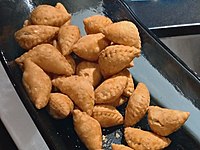Yau gok

This article needs additional citations for verification. (August 2012) |
 | |
| Alternative names | Gok zai (角仔) |
|---|---|
| Course | Chinese New Year dish |
| Place of origin | China |
| Region or state | Guangdong, Hong Kong and Cantonese-speaking areas |
| Main ingredients | glutinous rice dough, various meat fillings |
| Yau gok | |||||||||||||||||
|---|---|---|---|---|---|---|---|---|---|---|---|---|---|---|---|---|---|
| Chinese | 油角 | ||||||||||||||||
| Literal meaning | oil dumpling | ||||||||||||||||
| |||||||||||||||||
| Alternative Chinese name | |||||||||||||||||
| Chinese | 角仔 | ||||||||||||||||
| Literal meaning | small dumpling | ||||||||||||||||
| |||||||||||||||||
Yau gok (油角) or Jau gok (油角) is a traditional pastry found in Cantonese cuisine, originating from Guangdong Province in China. The term gok (角) reflects the crescent shape of the pastries;[1] they differ from the connotation of steamed or pan-fried Chinese dumplings, normally associated with the phonetically similar term Jiaozi (餃仔). They are most commonly prepared during Chinese New Year, and consumed in Cantonese-speaking regions and communities, including Hong Kong and Malaysia.[2]
Names
[edit]There are quite a number of unofficial English names associated with this dish:
- Peanut Puff
- Crispy triangles
- Fried oil dumplings
- New year dumplings
- Chinese new year dumplings
Preparation
[edit]The pastry wrap is first made of glutinous rice dough. A crescent shape is formed to hold the fried ingredients used as filling. A batch of the pastries are either baked or deep fried in a wok.[3]
Salty version
[edit]The savory version is generally called haam gok zai (simplified Chinese: 咸角仔; traditional Chinese: 鹹角仔; pinyin: xián jiǎo zǐ; Jyutping: haam4 gok3 zai2). There is a range of popular fillings that vary depending on regional culture. Common ingredients include pork, Chinese sausages, and Chinese black mushroom.[4]
Sweet version
[edit]The sweet version is generally called tim gok zai (Chinese: 甜角仔; pinyin: tián jiǎo zǐ; Jyutping: tim4 gok3 zai2). The standard filling comprises grounded peanuts, white sesame seeds, and desiccated (dried) coconut crumbs mixed with sugar.[5] After the frying, this version is crunchy. This version is suitable for vegetarians.
See also
[edit]References
[edit]- ^ "English translation of '角'". Collins dictionary.
- ^ "新年小食食譜|油角/角仔 (懶人簡易版)", Yahoo News, 27 January 2024
- ^ wantanmien (2012-01-14). "Chinese new year Yau kwok, 油角 (Cantonese)". YouTube.com. Archived from the original on 2021-12-21. Retrieved 14 August 2012.
- ^ "广东咸角仔很好吃,你会做吗?进来看我这样做". sohu.com. 10 May 2023.
- ^ Wong, Sonia (23 January 2023). "Fried Sweet Peanut Dumplings for a Prosperous Lunar New Year". Food Network Canada.